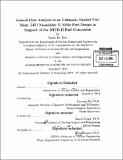Loss-of-flow analysis of an unfinned, graded fuel meat, LEU monolithic U-10Mo fuel design in support of the MITR-II fuel conversion
Author(s)
Don, Sarah M
DownloadFull printable version (10.79Mb)
Alternative title
LOF analysis of an unfinned, graded fuel meat, low-enriched uranium monolithic U-10Mo fuel design in support of the Massachusetts Institute of Technology Research Reactor fuel conversion
Other Contributors
Massachusetts Institute of Technology. Department of Nuclear Science and Engineering.
Advisor
Lin-wen Hu.
Terms of use
Metadata
Show full item recordAbstract
In order to satisfy requirements of the Global Threat Reduction Initiative (GTRI), the 6 MW MIT Research Reactor (MITR-II) is to convert from the current 93%-enr 235U highly-enriched uranium (HEU) fuel to the low-enriched uranium (LEU, <20% 235U) fuel. This reduction in enrichment decreases the neutron flux level due to parasitic absorption by 238U. The neutron flux may be compensated for by increasing the reactor's nominal operating power level to 7.0 MW. Thus a neutronic and thermalhydraulic study was undertaken to evaluate new fuel designs with graded fuel meat thickness and unfinned clad that provide sufficient safety margins for steady-state operation at 7.0 MW. A previously-studied 18-plate LEU fuel design and an identical unfinned fuel design were compared to evaluate the effect of fin removal, demonstrating the need for fuel redesign. A recent feasibility study has shown that a 19-plate, unfinned fuel design with graded fuel meat thicknesses (19B25) provides fuel cycle length and steady-state thermal hydraulic safety margins that meet the design criteria. The objective of this study was to use the RELAP5 MOD3.3 code to confirm the steady-state thermalhydraulic safety margin and to analyze the loss-of-flow (LOF) transient performance of this candidate fuel design. Power distributions obtained for beginning-of-life (BOL), middle-of-life (MOL), and end-of-life (EOL) were analyzed to study the effect of core power distribution and burnup-dependent thermal properties on safety margins. Results show that the MITR-II can safely operate at 7.0 MW with the proposed LEU fuel with an adequate margin (40%) to the onset of nucleate boiling (ONB) -limiting power level. The minimum margin between coolant channel wall and saturation temperatures was at least 22 C in the most limiting channel, in the most limiting core (BOL) at 7.0 MW. The proposed LEU fuel design also performed well during a simulated LOF transient after operation at 7.0 MW, with a peak fuel temperature of 106 C reached in the hot channel, which is well below the U-1OMo blistering temperature of 365*C. During the LOF transient, the maximum clad temperature was 980, meaning that no boiling occurred even during the LOF transient. Bounding analysis to evaluate the effect of an oxide layer and fuel meat thermal conductivity due to fuel burnup estimated that up to a 15 C peak fuel temperature rise can be attributed to increased thermal resistance of oxide layer and fuel thermal conduction reduction. Thus under the most conservative assumption, the estimated peak fuel temperature is 121 C, well under the blistering temperature limit of 365 C. It is concluded that the 19-plate unfinned fuel design with graded fuel meat thickness is a promising candidate for the conversion to LEU fuel and power uprate.
Description
Thesis: S.M., Massachusetts Institute of Technology, Department of Nuclear Science and Engineering, 2014. Thesis: S.B., Massachusetts Institute of Technology, Department of Nuclear Science and Engineering, 2014. Cataloged from PDF version of thesis. Includes bibliographical references (pages 113-115).
Date issued
2014Department
Massachusetts Institute of Technology. Department of Nuclear Science and EngineeringPublisher
Massachusetts Institute of Technology
Keywords
Nuclear Science and Engineering.